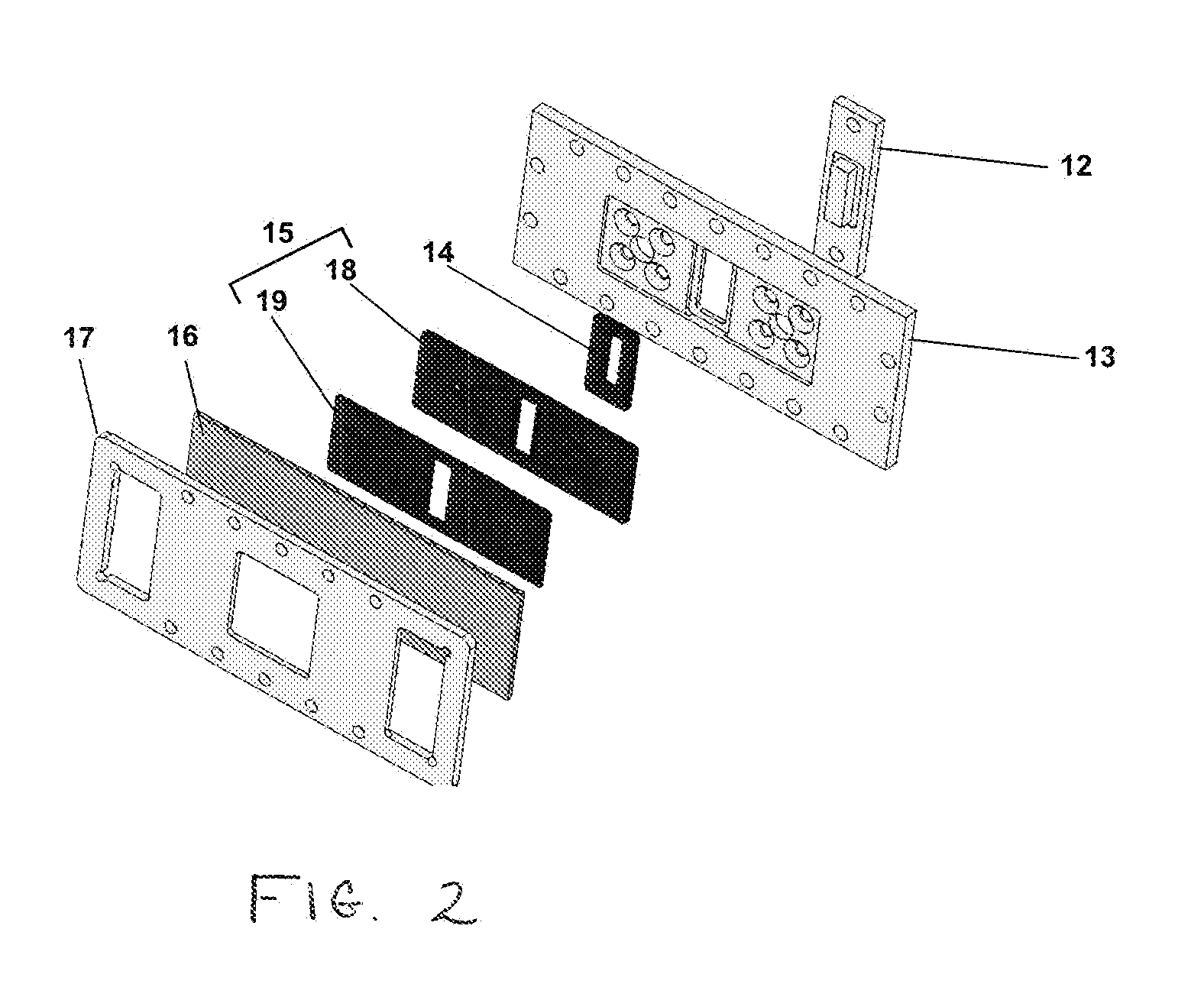Microfluidic Device
- Summary
- Abstract
- Description
- Claims
- Application Information
AI Technical Summary
Benefits of technology
Problems solved by technology
Method used
Image
Examples
example 1
[0100]Design of a Microfluidic Perfusion Bioreactor
[0101]As shown in FIG. 1A, to integrate a tissue culture polystyrene slide 6, a standard adherent cell culture material, into a microfluidic perfusion bioreactor, a clamp designed with integrated fluidic interconnects 2 was proposed, where a cell culture slide 6 and a microfluidic chip 5 were disposed between a bottom frame 7 and a top plate 3.
[0102]The clamp was held together by screws, where the soft microfluidic chip formed a seal between the culture slide and the interconnects in the top plate. In some embodiments, any fastening mechanism known in the art may be used to hold the MPB together. As shown in FIG. 1A, the top plate 3 included two pockets to hold the gasket 4 and the microfluidic chip 5 and which allowed alignment of the microfluidic chip with the inlet and outlet interconnects 2. Interconnects 2 were mounted on the top plate 3 with screws and a portion of the interconnects extend through a hole in the top plate 3. A ...
example 2
[0115]Fabrication and Assembly of the Microfluidic Bioreactor
[0116]All parts and moulds were designed in a 3D CAD system (SolidWorks 2007, Dassault Systemes SolidWorks, USA). G-code was generated with a CAM program (MasterCam X2, CNC Software, USA) to control the milling process on a micro milling machine (M3400E, Folken Industries, USA).
[0117]To mill the bottom frame 7 and top plate 3 (shown in FIG. 1A), a 3 mm thick poly(carbonate) (PC) sheet (681-637, RS, UK) was machined (8,000 rpm, 104 mm min−1 feedrate) using 2 mm diameter end mills (2 flute standard length, Kyocera Micro Tools, USA).
[0118]The lid 1 as depicted in FIG. 1A was machined from a 5 mm thick PC sheet (681-659, RS, UK) using 2 mm diameter and 1 mm diameter end mills (2 flute standard length, Kyocera Micro Tools, USA).
[0119]Instead of using a SU-8 process, which creates a master for PDMS reproduction, the inventors used a micromilling machine to fabricate moulds for the microfluidic chip (FIG. 5) and the gasket.
[0120]...
example 3
[0154]Imaging
[0155]For the perfusion experiments and the control wells, we used an inverted microscope (Nikon Eclipse TE2000-U, Nikon Corporation, Japan) with a colour microscope camera (Nikon DS-Fil, Nikon Corporation, Japan) for daily inspection and endpoint assays.
[0156]To enhance the immunostaining contrast, the inventors used Photoshop (Photoshop CS3, Adobe Inc., USA).
[0157]Results
[0158]It was found that the hESC in the MPB were healthy and showed no difference compared to the controls demonstrating that the MPB does not have any detrimental effect on the hESC in any way. This was demonstrated by the fact that the pluripotency of the hESC determined by morphology and immunostaining seemed equal or better than in the static control dish, i.e. the hESC had retained their pluripotency.
[0159]Discussion
[0160]The above described chip-to-world device offers a robust method of linking a microfluidic chip with the “macro-world”. The interface includes a loading port, which can easily an...
PUM
| Property | Measurement | Unit |
|---|---|---|
| Temperature | aaaaa | aaaaa |
| Fraction | aaaaa | aaaaa |
| Time | aaaaa | aaaaa |
Abstract
Description
Claims
Application Information
 Login to View More
Login to View More - R&D
- Intellectual Property
- Life Sciences
- Materials
- Tech Scout
- Unparalleled Data Quality
- Higher Quality Content
- 60% Fewer Hallucinations
Browse by: Latest US Patents, China's latest patents, Technical Efficacy Thesaurus, Application Domain, Technology Topic, Popular Technical Reports.
© 2025 PatSnap. All rights reserved.Legal|Privacy policy|Modern Slavery Act Transparency Statement|Sitemap|About US| Contact US: help@patsnap.com



